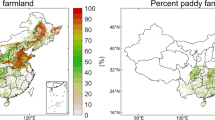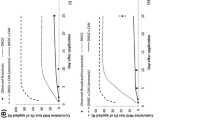Abstract
A regional nitrogen cycle model, named IAP-N, was designed for simulating regional nitrogen (N) cycling and calculating N fluxes flowing among cultivated soils, crops, and livestock, as well as human, atmospheric and other systems. The conceptual structure and calculation methods and procedures of this model are described in detail. All equations of the model are presented. In addition, definitions of all the involved variables and parameters are given. An application of the model in China at the national scale is presented. In this example, annual surpluses of consumed synthetic N fertilizer; emissions of nitrous oxide (N2O), ammonia (NH3) and nitrogen oxide (NO x ); N loss from agricultural lands due to leaching and runoff; and sources and sinks of anthropogenic reactive N (Nr) were estimated for the period 1961–2004. The model estimates show that surpluses of N fertilizer started to occur in the mid 1990s and amounted to 5.7 Tg N yr−1 in the early 2000s. N2O emissions related to agriculture were estimated as 0.69 Tg N yr−1 in 2004, of which 58% was released directly from N added to agricultural soils. Total NH3 and NO x emissions in 2004 amounted to 4.7 and 4.9 Tg N yr−1, respectively. About 3.9 Tg N yr−1 of N was estimated to have flowed out of the cultivated soil layer in 2004, which accounted for 33% of applied synthetic N fertilizer. Anthropogenic Nr sources changed from 2.8 (1961) to 28.1 Tg N yr−1 (2004), while removal (sinks) changed from to 2.1 to 8.4 Tg N yr−1. The ratio of anthropogenic Nr sources to sinks was only 1.4 in 1961 but 3.3 in 2004. Further development of the IAP-N model is suggested to focus upon: (a) inter-comparison with other regional N models; (b) overcoming the limitations of the current model version, such as adaptation to other regions, high-resolution database, and so on; and (c) developing the capacity to estimate the safe threshold of anthropogenic Nr source to sink ratios.
Similar content being viewed by others
References
Bao, S., 2000: Soil and Agricultural Chemistry Analysis. China Agricultural Press, Beijing, 485pp.
Cao, M., and Y. Zhuang, 1996: Measurement and distribution of N2O emission from biomass burning. Monitoring of Concentration and Emissions of Greenhouse Gases and Relevant Processes, G. Wang and Y. Wen, Eds., Chinese Envirionmental Science Press, Beijing, 320–325.
Chen, C., J. Xu, C. Liang, and Y. Huang, 2001: Aluminium stress on sugar cane growth. Sugar Cane, 8(1), 10–14. (in Chinese)
Galloway, J. N., J. D. Aber, J. W. Erisman, S. P. Seitzinger, R. W. Howarth, E. B. Cowling, and B. J. Cosby, 2003: The nitrogen cascade. BioScience, 53, 341–356.
Galloway, J. N., and Coauthors, 2004: Nitrogen cycles: past, present, and future. Biogeochemistry, 70, 153–226.
Graedel, T. E., D. T. Hawkins, and L. D. Claxton, 1986: Atmospheric Chemical Compounds: Sources, Occurrence, and Bioassay. Academic Press, Orlando, FL, USA, 732pp.
Huang, Y., and W. J. Sun, 2006: Changes in topsoil organic carbon of croplands in mainland China over the last two decades. Chinese Science Bulletin, 51(15), 1785–1803.
IPCC (Intergovernmental Panel on Climate Change), OECD (Organization for Economic Co-operation and Development) and IEA (Internatinal Energy Agency), 1997: Revised 1996 IPCC Guidelines for National Greenhouse Gas Inventories, Greenhouse Gas Inventory Referance Manual. Volume 3, Houghton et al., Eds., IPCC/OECD/IEA. UK, Meteorological Office, Bracknell, UK.
IPCC (Intergovernmental Panel on Climate Change), 2000: Good Practice Guidance and Uncertainty Management in National Greenhouse Gas Inventories. Institute for Global Environmental Strategies, Kaganawa, Japan.
IPCC (Intergovernmental Panel on Climate Change), OECD (Organization for Economic Co-operation and Development) and IEA (Internatinal Energy Agency), 2006: Draft 2006 IPCC Guideline for National Greenhouse Gas Inventories. Kaganawa, Japan.
JNHA (Jiangsu Agricultural College, Nanjing Agricultural University, Hubei Agricultural College, and Anhui Agricultural College), 1991: Crop Cultivation. Agriculture Press, Beijing, 450pp. (in Chinese)
Ju, X., X. Liu, F. Zhang, and M. Roelcke, 2004: Nitrogen fertilization, soil nitrate accumulation, and policy recommendations in several agricultural regions of China. Ambio, 33, 300–305.
Kundu, D. K., and J. K. Ladha, 1995: Efficeient management of soil and biologically fixed N2 in intensively-cultivated rice fields. Soil Biology Biochemistry, 4/5, 431–439.
Lin, B., J. Lin, and J. Li, 1994: The changes of crop yield and soil fertility with long-term fertilizer application. Plant Nutrition and Fertilizer Science, 1, 6–18. (in Chinese)
Lu, R. K., H. X. Liu, D. Z. Wen, S. W. Qin, J. Y. Zheng, and Z. Q. Wang, 1991: Studies on nutrient cycle and equilibrium in a typical agroecological system in China (I). Chinese Journal of Soil Science, 27, 139–154. (in Chinese)
Ma, L. S., Z. Q. Wang, S. M. Zhang, X. F. Ma, and G. Y. Zhang, 1997: Pollution from agricultural nonpoint sources and its control in river system of Taihu Lake, Jiangsu. Acta Scientia Circumstantiae, 17, 39–47. (in Chinese)
Meng, Y., S. Li, and T. Li, 2001: Generational characteristics of late wheat and cultivation techniques for purpose of high yield. Chinese Journal of Wheat Research, 22(2), 27–29. (in Chinese)
MOA/DOE PET (Ministry of Agriculture/Division of Energy Project Expert Team), 1998: Assessment of Biomass Resource Availability in China. China Environmental Science Press, Beijing, 270pp. (in Chinese)
Moiser, A. R., C. Kroeze, C. Nevison, O. Oenema, S. Seitzinger, and O. van Cleemput, 1998: Closing the global atmospheric N2O budget: Nitrous oxide emissions through the agricultural nitrogen cycle. Nutrient Cycling in Agroecosystems, 52, 225–248.
Ryden, J. C., L. J. Lund, J. Letey, and D. D. Focht, 1979: Direct measurement of denitrification loss from soils: II. Development and applicaiton of field methods. Soil Science Society of American Journal, 43, 110–119.
Sanhueza, E., and P. J. Crutzen, 1998: Budgets of fixed nitrogen in the Orinoco Savannash region: role of pyrodenification. Global Biogeochemical Cycles, 12, 653–666.
Smil, V. 2001: Enriching the Earth. The MIT Press, Cambridge, MA. 338 pp.
Socolow, R. H., 1999: Nitrogen management and the future of good: Lessons from the management of energy and carbon. Proceeding of the National Academy of Sciences of the United Atates of America (PNAS), 96, 6001–6008.
Tang, G., B. Jin, and S. Ding, 2000: Effect of ABT rooting powder on seed germination and seedling growth and development of barley. Barley Sciences, 2000(4), 31–33. (in Chinese)
Wang, M. X., 1999: Atmospheric Chemistry. 2nd ed, China Meteorological Press, Beijing, 467pp. (in Chinese)
Xing, G. X., and Z. L. Zhu, 2000: An assessment of N loss from agricultural fields to the environment in China. Nutrient Cycling in Agroecosystems, 57, 67–73.
Zhang, F., and Z. Zhu, 1990: Harvest index of Chinese crops. Chinese Agricultural Sciences, 23(2), 83–87. (in Chinese)
Zheng, X, C. Fu, X. Xu, X. Yan, Y. Huang, G. Chen, S. H. Han, and F. Hu, 2002: The Asian nitrogen cycle case study. Ambio, 31(2), 79–87.
Zheng, X. H., Y. Huang, Y. S. Wang, and M. X. Wang, 2003: Seasonal characteristics of nitric oxide emission from a typical Chinese rice-wheat rotation during the non-waterlogged period. Global Change Biology, 9(2), 219–227.
Zheng, X., S. H. Han, Y. Huang, Y. S. Wang, and M. X. Wang, 2004: Re-quantifying the emission factors based on field measurements and estimating the direct N2O emission from Chinese croplands. Global Biogeochemical Cycles, 18, GB2018, doi:10.1029/2003GB002167.
Zheng, X., and Coauthors, 2006: Nitrogen-regulated effects of free-air CO2 enrichment on methane emissions from paddy rice fields. Global Change Biology, 12(9), 1717–1732.
Zhu, Z. L., 1997: Nitrogen balance and cycling in agroecosystems of China. Nitrogen in Soils of China, Zhu et al., Eds., Kluwer Academic Publishers, Dordrecht/Boston/London, 323–330. (in Chinese)
Zhu, Z. L., and Q. X. Wen, 1992: Nitrogen in Soils of China. Jiangsu Science and Technology Publishing House, Nanjing, Jiangsu, China, 303pp. (in Chinese)
Author information
Authors and Affiliations
Corresponding author
Rights and permissions
About this article
Cite this article
Zheng, X., Liu, C. & Han, S. Description and application of a model for simulating regional nitrogen cycling and calculating nitrogen flux. Adv. Atmos. Sci. 25, 181–201 (2008). https://doi.org/10.1007/s00376-008-0181-7
Received:
Revised:
Published:
Issue Date:
DOI: https://doi.org/10.1007/s00376-008-0181-7




